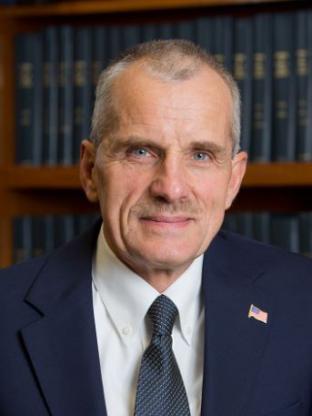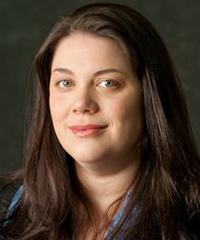Simon Corrie research interest is focused on developing nano-particle-based molecular sensors for monitoring biological molecules in real biological environments. The Nano-sensor Engineering Lab works on the design, synthesis, characterization and testing of both synthetic nano-particle scaffolds (e.g. organosilica materials) and novel biological reporters (e.g. antibody fragments). This requires an interdisciplinary approach, combining aspects of materials science, chemistry, and molecular biology to create the materials and then collaborate with Australian and international colleagues to test the materials in pre-clinical animal models with the ultimate aim of translation into human trials.
Gil Garnier
Professor Gil Garnier is the Director of BioPRIA within the Department of Chemical Engineering at Monash University. His current research interests are focused on the application of colloids and polymers to surfaces, adhesion, composites, and the process of papermaking.
Prof. Garnier’s research and development activities aim at developing low-cost biomedical diagnostics and implementing Biorefineries. He achieves these objectives by applying the concepts of colloid and surface chemistry, polymer physics, green chemistry, material and process engineering to renewable lignocellulosic materials such as wood and agriculture residues. His activity gravitates around three platforms: 1) Surfaces and Bio-diagnostics, 2) Nanocellulose and Nanocomposites, and 3) Green Chemistry and Sustainable Processes.
Huanting Wang
Prof Huanting Wang is a Professor in the Department of Chemical Engineering, Associate Dean (International) of Faculty of Engineering and Director of the Monash Centre for Membrane Innovation at Monash University.
Originally qualified in material science and engineering at the University of Science and Technology of China, he completed a postdoctoral research fellowship in Chemical Engineering at the California Institute of Technology and University of California Riverside. Professor Wang was awarded an ARC QEII Fellowship in 2004 and an ARC Future Fellowship in 2010. He was a member of the ARC Future Fellowship selection advisory committee in 2011, and and a member of the ARC College of Experts in 2012-2015. He was a Board Member of the Membrane Society of Australasia, and is a Fellow of The Royal Society of Chemistry, a Fellow of The American Institute of Chemical Engineers, and a Council Member of the Aseanian Membrane Society
Xiwang Zhang
Xiwang Zhang is a Professor of Department of Chemical Engineering and the Director of the ARC Research Hub for Energy-efficient Separation. After obtaining his Ph.D degree from Research Centre of Eco-Environmental Sciences, Chinese Academy of Sciences in 2006, he joined Nanyang Technological University, Singapore as Research fellow and was then promoted to a Senior Research Fellow in 2009. In 2010, Prof. Zhang joined Keppel, a multinational corporation in Singapore, as R&D Manager in Keppel Environmental Technology Centre. Prof. Zhang was awarded the prestigious ARC Australian Research Fellowship in 2010 and commenced his ARC fellowship at University of Queensland in 2011. He was then awarded the prestigious Larkins Fellowship in 2012 by Monash University, which brought him to Monash University at associate professor level in end of 2012. He was promoted to full professor in 2017. Prof. Zhang’s research interests focus on membrane and advanced oxidation technologies for water and wastewater treatment.
Warren Batchelor
Warren Batchelor works in the BioProcessing Research Institute of Australia (BioPRIA) within the Department of Chemical Engineering at Monash University. He is an expert on paper as a nonwoven cellulose fibre material, including the relationships between sheet properties and internal structure. His research group is heavily focused on the production and application of cellulose nanofibres. These are a new, fully recyclable and biodegradable nanofibre made by breaking down cellulose fibres from wood or agricultural residue. Reducing the fibre diameter by over three orders of magnitude reduces the size of the pores between the fibres, once formed into sheets, greatly improving the performance of the sheet as a barrier to water vapour and oxygen, or as an ultrafiltration membrane in liquid filtration. The pore size can be further reduced by making composites of cellulose nanofibres and nanoparticles. Other applications of this versatile material include as an additive in paper manufacture, as a substrate for flexible printed electronics and as reinforcement in modern light-weight composites
Akshat Tanksale
Petroleum reserves are rapidly depleting and there is no clear alternative as yet. Dr Akshat Tanksale believes that innovating new processes and designing novel heterogeneous catalysts at the nanoscale is the key for developing low carbon emission alternative fuels and chemicals. As group leader of the Catalysis for Green Chemicals group at Monash University, he is working in the field of nanomaterials to reduce human resilience on conventional fossil fuels, like petroleum, which are diminishing in amount and are also responsible for climate change through carbon dioxide pollution.
He is collaborating with the Banaszak Holl lab to develop new methods for polymer depolymerization.
James Ashton-Miller
Dr. Ashton-Miller and his students and orthopaedic and engineering colleagues are testing the hypothesis that anterior cruciate ligament (ACL) tears, a common sports injury, are a cumulative trauma disorder resulting from fatigue-related microdamage at the femoral enthesis. Insights will have implications for better prevention of these injuries.
Edward Wojtys
Dr. Edward Wojtys, who is an Orthopaedic Surgeon and MSK Core Center member, was recently honored by being inducted into the American Orthopaedic Society for Sports Medicine Hall of Fame. Dr. Wojtys is a physician-scientist who has dedicated his academic career to studying the ACL.
Stassi DiMaggio
Stassi DiMaggio was a visiting professor of chemistry at the University of Michigan working with Prof. Banaszak Holl and his colleagues at the Michigan Nanoscience Institute for Medical and Biological Sciences (MNiMBS). Her regular gig is a position at Xavier University in New Orleans as an associate professor of chemistry. Stassi is working on the conjugation of PAMAM dendrimers for basic scientific studies of nanoparticle/membrane interactions as well as developing a new nanotherapeutic for lung cancer.
Stassi’s 2008 ACS Nano paper was featured in the February 2011 ACS Nano Virtual Special Issue on Drug Delivery.
Seok-ki Choi
Dr. Choi is a research assistant professor at Michigan Nanotechnology Institute for Medicine and Biological Sciences (MNIMBS), Department of Internal Medicine, University of Michigan. He earned his BS and MS degrees both at Seoul National University, Korea, and PhD degree (1994) in Organic Chemistry at Columbia University, NY. His dissertation work under Professor Koji Nakanishi focused on synthesis of biologically active natural products and mode of action studies. He then joined in Professor George M. Whiteside laboratories at Harvard University as postdoctoral fellow where he performed proof of concept studies of polyvalent applications in biological systems focusing on pathogen-cell adhesion.
Dr. Choi started his career as research scientist at Theravance at South San Francisco in 1997, and played a significant role in exploring proprietary applications of polyvalent strategy for novel drug discovery. His research efforts led to discovery of several therapeutic candidates in clinical trials including those for treatment of asthma and chronic obstructive pulmonary diseases, and gastrointestinal motility, hetero-divalent antibacterial agents, and antihypertensive dual-acting small molecule inhibitors.
Dr. Choi joined in Michigan Nanotechnology Institute for Medicine and Biological Sciences in late 2008. His research interests focus on integration of polyvalent concept in biologic nanotechnology. His primary research objectives include rational design of nanodevices at molecular level for the cancer targeted delivery of therapeutic molecules. He is also investigating the problems of PAMAM dendrimer as the organophosphate agent-responsive drug carrier, and the design of photocleavable linkers for active drug release mechanisms in targeted delivery.
Roya Lahiji
Roya earned her PhD in Physics-Nanotechnology from Purdue University in 2008. Then she worked as a post-doctoral fellow at the University of Alberta and National Institute for Nanotechnology, Canada. Her expertises are on AFM, materials characterization and surface science, cellulose nanocrystals, carbn nanotubes, molecular electronics and nanocomposites. In 2011, she joined our group as an Assistant Research Scientist. She worked on the development of microfluidic patch-clamp techniques for measurement of biological membrane disruption as well as collaborating with groups from other universities to study cell interaction with different environments.
James R. Baker, Jr.
James R. Baker, Jr., M.D., Director of the Michigan Nanotechnology Institute for Medicine and the Biological Sciences (M-NIMBS), completed his undergraduate education at Williams College in Williamstown, Massachusetts. After an internship and internal medicine residency at the Walter Reed Army Medical Center in Washington, D.C., he completed an Allergy and Clinical Immunology Fellowship, also at Walter Reed and at NIAID. In 1988, Dr. Baker was appointed as Associate Professor in the Departments of Medicine and Surgery at the Uniformed Services University of the Health Sciences. He joined the faculty of the University of Michigan in 1989. In 1993, Dr. Baker was appointed as Chief of the Division of Allergy in the Department of Internal Medicine. He was promoted to Professor of Internal Medicine on May 17, 1996. In June of 2001 Dr. Baker was inaugurated as the first recipient of the Ruth Dow Doan Endowed Professorship in Biologic Nanotechnology. Because Dr. Baker has distinguished himself as both a national and an international leader in the field of biologic nanotechnology, in October of 2001 he was named as the first recipient of the U-M Dean’s Innovation Award. In June, 2003, he was appointed to serve as a member of the newly formed Nanotechnology Technical Advisory Group (N-TAG) of the President’s Council of Advisors on Science and Technology (PCAST) to the Executive Office of the President of the United States. In September, 2004, Dr. Baker was named as one of the three editors of the National Nanotechnology Initiatives’ research directives. He is a member of the President’s Council of Advisors on Science and Technology (PCAST) and is the only physician on this important Office of Science and Technology Policy committee. Dr. Baker presently serves as Co-Chair of the American Academy of Allergy, Asthma and Immunology’s Vaccines and Biological Threats Committee. He also serves as a board member representing the University of Michigan on the Region V Regional Center of Excellence for Biodefense and Emerging Infectious Diseases (the Great Lakes Regional Centers of Excellence). He is a 14-year veteran of service in the U.S. Military, 12 of which were on active duty, including service during Operation Desert Storm.
Rong Qi
Rong earned her Ph.D. in Pharmaceutical Science from China Pharmaceutical University in 2004 and is currently a professor at Peking University. Her research focuses on PEG-conjugated dendrimers as in-vitro and in-vivo DNA and RNA delivery vectors. She is collaborating with our group on the endocytosis mechanism of polycationic dendrimer-DNA polyplexes using biochemistry techniques to up- or down-regulate some crucial receptors or proteins, which are related to internalization pathways of the polyplexes.
Rona and Mark at IDS10 in Weihai, China Summer 2017.

Kumar Sinniah
Kumar is a professor of chemistry at Calvin College in Grand Rapids, Michigan. His research interests are on single molecule approaches to studying bio-molecular interactions and surface visualization. He has held visiting faculty positions at the University of Maryland and the University of Cambridge, UK.
In his spare time he loves to spend time with his family, travel, and play the piano and is a great fan of Radiohead and Muse.

May 2009, The Last Day of Sabbatical Leave
Gihane Nasr
Gihane Nasr received a B.S. degree in chemistry from the Lebanese University in Lebanon. She then pursued a Masters degree in Biomolecular chemistry from the University of Montpellier in France in 2004 where she worked on the synthesis of new drugs for Carbonic Anhydrase enzyme. Her PhD research focused on the elaboration of dynameric membranes for gas separation at the European Membranes Institute in Montpellier, France. In 2009 she joined the University of Versailles as a post-doc and worked on the synthesis of Iridium and Ruthenium complexes and the elaboration of OLEDs (organic light emitting diodes). In 2011 she became an associate professor at the Lebanese University. She joined the Banaszak Holl group in August 2016 as a Fulbright scholar where her research focuses on the encapsulation of essential oils in dendrimers for cosmetic applications.
Selected publications:
Carbonic anhydrase inhibitors. Inhibition of human cytosolic isoforms I and II with (reduced) Schiff’s bases incorporating sulfonamide, carboxylate and carboxymethyl moieties, G. Nasr, A. Cristiana, M. Barboiu, D. Vullo, J.-Y. Winum, C. T. Supuran, Bioorganic & Medicinal Chemistry 2014, 22, 2867-2874
Metallodynameric membranes – toward the constitutional transport of gases, G. Nasr, T. Macron, A. Gilles, Z. Mouline, M. Barboiu, Chemical Communications 2012, 48, 6827-6829
Systems membranes – combining the supramolecular and dynamic covalent polymers for gas-selective dynameric membranes, G. Nasr, T. Macron, A. Gilles, Eddy Petit, M. Barboiu, Chemical Communications, 2012, 48, 7398-7400
Dithiolate-Appended Iridium(III) Complex with Dual Functions of Reducing and Capping Agent for the Design of Small-Sized Gold Nanoparticles, G. Nasr, Audrey Guerlin, F. Dumur, S. A. Baudron, E. Dumas, F. Miomandre, G. Clavier, M.Sliwa, C. R. Mayer, Journal of American Chemical Society 2011, 133 (17), 6501- 6504
Clifford Les
Dr.Les is head of the Anatomy Section of the Bone and Joint Center, Henry Ford Hospital, Detroit. His research program is concentrated in examining the interactions between material properties, microstructure, and macrostructure of bone. We have identified regional variations in the materials and mechanical properties of bone that affect the way the bone organ deforms under normal use, and have characterized changes in these variations that accompany estrogen depletion (e.g. menopause) and replacement, unloading, short-term tissue injury, and changes in nutritional status.
In addition, Dr Les is involved in work with other members of the SE Michigan orthopaedics research community in examining the changes in local kinematics that lead to osteoarthritis in the ACL-deficient knee, the cellular effects of local treatment of giant cell tumors, the use of stem cells as delivery systems for gene therapy in the treatment of articular fractures, the mechanisms of early growth-plate closure, the effect of light exposure, calendar season, and Vitamin D on the viscoelastic properties of bone material and structure, and the functional damping characteristics of equine fetlock joint tissues.
To examine the mechanisms behind these normal phenomena and disease processes, Dr.Les and his team of researchers make use of microscopic imaging of bone, viscoelastic mechanical testing of bone materials and structure, and bulk analysis of mineral and cytokines within bone and other musculoskeletal tissues.
Dr. Les continues to serve the veterinary community in the field of regulatory veterinary medicine, taking part in recent efforts to control Foot-and-Mouth Disease in northern England and Chronic Wasting Disease in Wisconsin, and is a member of the Michigan Veterinary Corps, a network of Michigan veterinarians trained in the rapid response to outbreaks of large animal infectious diseases. He serves as an orthopaedic research consultant to the AO Foundation in Switzerland, the Austrian Fund for Animals, the British Horseracing Levy Board, the University of Guelph, and the National Institutes of Health, and holds faculty positions at Colorado State University, Michigan State University, and Wayne State University.
Bradford Orr
Professor Orr’s research centers on systems where the properties are controlled by the characteristics of surfaces or interfaces. As designed structures become ever smaller, their surface characteristics begin to influence, or even control, their behavior. Often the research involves scanning probe microscopies such as STM and AFM. Specific examples of research interests include: studies of molecules adsorbed on Si and Au surfaces; the molecular origin of negative differential resistance in metal-insulator-metal devices; the mechanism for composition modulation in compound semiconductors grown by molecular-beam epitaxy; and the development of multifunctional nanoparticles as therapeutics for cancer treatment.
The demand for smaller, faster silicon-based MOSFET’s necessitates the creation of thinner, more stable insulating silicon oxide (SiO2) layers. To achieve this a detailed understanding of the oxidation process and the structure of the Si/SiO2 is key. His group’s research has involved examining a model of this interface and determining the structure with atomic resolution. The theme of atomically resolved surface structure continues in research on the MBE growth of compound semiconductors and the spontaneous creation of compo-sitionally modulated superlattices. His group is also examining novel molecules that bind to gold and form self-assembled monolayers.
A second part of his research is the creation of targeted drugs for chemotherapy. This work involves the study of functionalized poly-(amidoamine)dendrimers as drug transport agents. We are studying the interaction of these nanoparticles with lipid layers, cell membranes and cells. In situ AFM has been used to examine cell apoptosis (programmed cell death) that occurs as a result of successfully killing the cancer cell.














